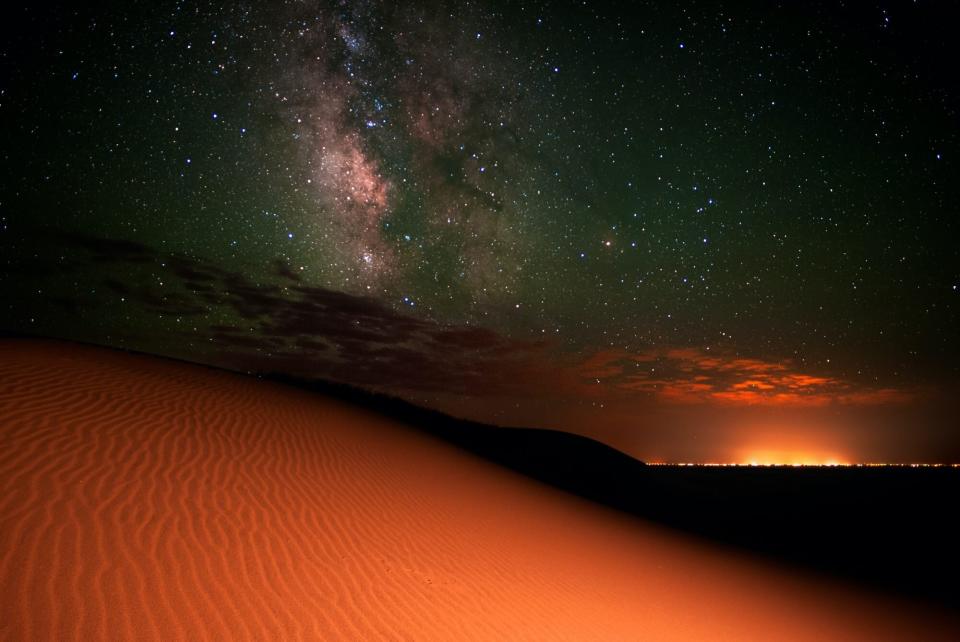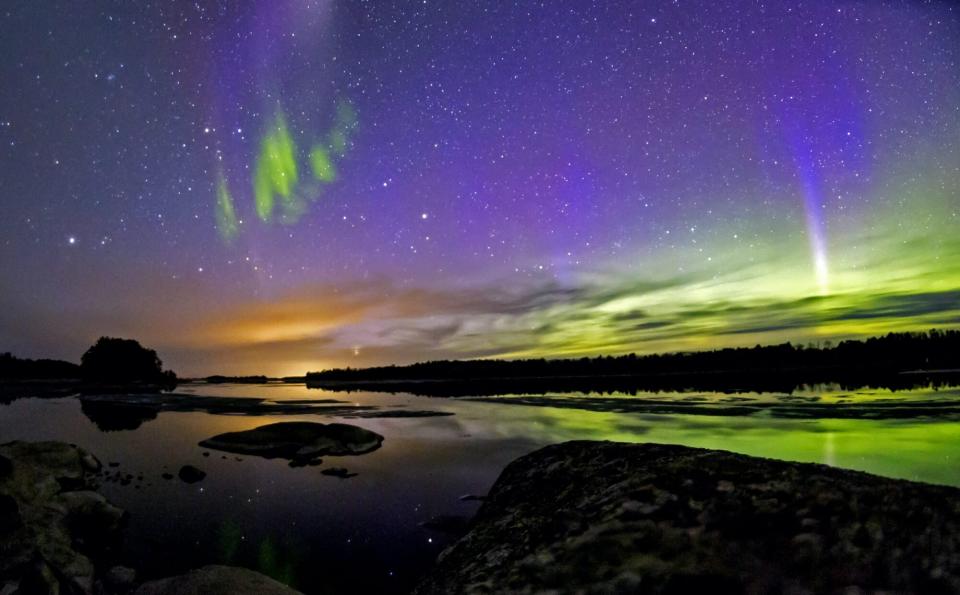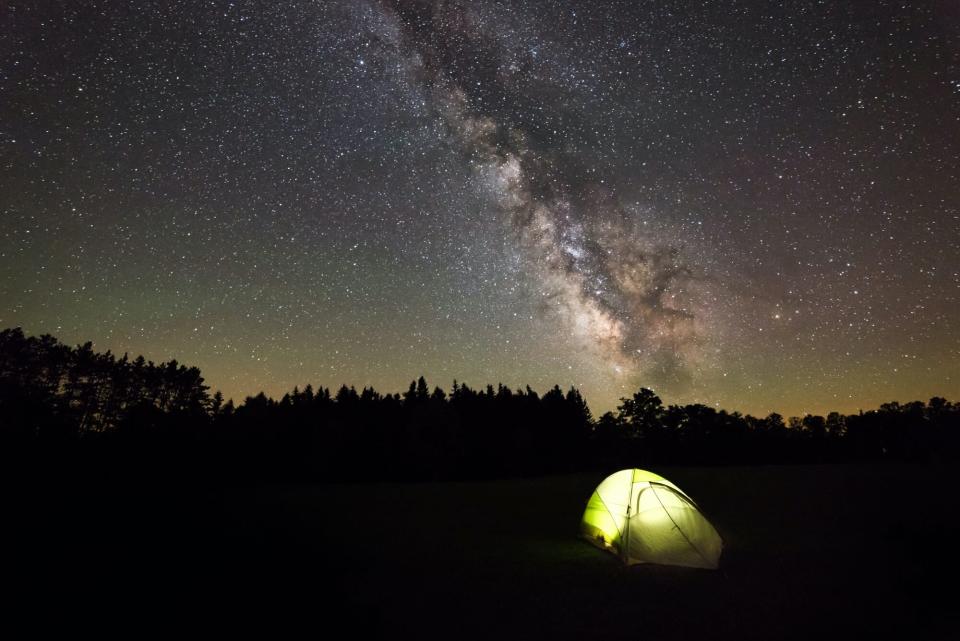15 Best Places to Stargaze in the U.S.
When traveling for scenic views, people spend a lot of time looking out—looking out at the road ahead, out the plane or hotel window, out at a sweeping landscape, you get the idea. There's a lot to be said, however, for looking up, especially when it's late at night. In some places, this will only get you a view of light pollution and hazy, purplish skies. In other areas, though, like those identified by the International Dark-Sky Association (IDA), you'll get the best, most mesmerizing views of stars, constellations, and planets.
There are over 180 locations certified by the International Dark-Sky Places Program, which is dedicated to preserving and protecting dark sites across the world. While many of the U.S. spots are concentrated in the West, there are great places to see stars in every region of America—so an awe-inspiring night of stargazing is only ever a quick road trip away. Below, read our abbreviated list of some of the darkest skies across the U.S. and find the best places to stargaze near you.
RELATED: 6 Best Stargazing Apps for Spotting the Next Big Astronomy Event
Best places to stargaze in the West:

Getty Images
Great Sand Dunes National Park, Colorado
This Colorado national park is home to the tallest sand dunes in North America (with some rising over 700 feet tall) and offers daytime activities like sandboarding, sand sledding, horseback riding, and more. At night, the dunes become the wavy foreground to a clear view of the Milky Way. The background noise—the calls of owls, frogs, toads, and more wildlife creatures—will help set the scene even more.
Glacier National Park, Montana
With over 700 miles of scenic trails, Glacier National Park is a popular destination for a hiking trip—which can be made even better by spending the night looking up at the stars. Glacier has been recognized by the IDA since 2017, but in 2021, became the first transboundary international dark sky park, sharing the designation with Waterton Lakes National Park just across the Canadian border. If you time your trip right, you might even be able to catch the northern lights. Just be sure to check your passport status and look up border hours before you go if you're looking to span both nations when you visit.
Death Valley National Park, California/Nevada
If you're looking for experiences that can remind you of the vastness of the universe, Death Valley National Park will deliver both day and night. The desert mountain park, which straddles the California-Nevada border, covers over 5,000 miles of land and the skies are so dark that it's been classified at the highest ("Gold Tier") level by the IDA for its star-filled skies. In fact, some of the astronomical objects that can be spotted at Death Valley are rare and can only be seen at the darkest locations across the world. Each spring, the park also hosts a Dark Sky Festival, with educational ranger programs, activities, speakers from organizations like NASA, and, of course, plenty of stargazing.
Central Idaho Dark Sky Reserve, Idaho
Stargazing is the principal purpose of this Central Idaho spot—which is America's first International Dark Sky Reserve. The designation, earned in 2017, is a result of nearly two decades of local efforts to reduce light pollution in the area. In the summer, the reserve offers hiking, biking, white water river rafting, fishing, and camping, and in the winter, visitors can ski and snowmobile through the mountains.
Massacre Rim, Nevada
One of the most important qualifications of a great stargazing place is that it's far enough away from human populations to avoid light pollution. Massacre Rim easily fits this qualification (and then some) with the nearest urban areas over 150 miles away. The publicly-owned wilderness study area has even been named one of the darkest places in the world, and officially became an International Dark Sky Sanctuary in 2019—one of only 15 in the world so far. So, unless you've made a trip to the other sanctuaries, it's safe to say the night sky here will be unlike anything you've ever seen.
Cosmic Campground, New Mexico
Ahead of Massacre Rim and the other six International Dark Sky Sanctuaries in the U.S., Cosmic Campground was the first to earn this designation in the country. The site is located in the Gila National Forest and offers a 360-degree unobstructed view of the night sky, making it a prime location to see stars. Because there's no electric lighting within 40 miles of the campground, the nighttime viewing experience is said to be close to those that existed before the introduction of electric lighting in the late 19th century.
Best places to stargaze in the Midwest:

Getty Images
Voyageurs National Park, Minnesota
Minnesota, the land of over 14,000 lakes, is home to this water-based National Park. A daytime visit can be spent hiking the trails and doing activities on the water (like boating, kayaking, and fishing), but a nighttime stay at one of the park's hundreds of campsites is a must to view the starry skies. To really get the most out of your trip, be sure to check out the Alaska Geophysical Institute's Aurora Forecast and NASA's sky calendar to increase your chance of seeing the northern lights.
Beverly Shores, Indiana
On the shoreline of Lake Michigan, just east of the Greater Chicago Area, is the small remote town of Beverly Shores. The town, which has a projected population of under 600 people, has been designated as an International Dark Sky Community—which, according to the IDA, is a community "that has shown exceptional dedication to the preservation of the night sky through the implementation and enforcement of a quality outdoor lighting ordinance, dark sky education and citizen support of dark skies." Located along the Indiana Dunes National Lakeshore, visitors can spend a day exploring the sand dunes and spend the night looking up at the stars.
Homer Glen, Illinois
Homer Glen is also a designated Dark Sky Community and yet another opportunity for Chicagoans or other Midwesterners to see the milky way. While the city is much larger than Beverly Shores, with around 25,000 residents, it's dedicated to managing and reducing light pollution for better night sky viewing.
Best places to stargaze in the Northeast:

Getty Images
Cherry Springs State Park, Pennsylvania
While the park is named for its black cherry trees and has impressive wilderness views by day, it's best known for its nighttime views of the Milky Way—which is said to be so bright that it casts a shadow. There are reservable campsites for overnight stays or visitors can venture to The Night Sky Public Viewing Area to spend just a few hours stargazing. Anyone who lives nearby might even consider purchasing a Galaxy Pass to the Overnight Astronomy Observation Field, which allows pass-holders a full year of overnight admission rather than a per-night fee.
Katahdin Woods and Waters National Monument, Maine
For enchanting views both day and night, Katahdin Woods and Waters National Monument is a great choice. In addition to the mountainscapes, the monument is filled with rivers, streams, woods, and plenty of flora and fauna to satisfy anyone in need of a nature escape. It's also designated as an International Dark Sky Sanctuary and offers sweeping views of stars, planets, and occasionally, the northern lights.
Acadia National Park, Maine
Though Acadia has yet to be designated an official Dark Sky Park, it's dark skies are impressive considering it's location on the east coast and proximity to Portland, Boston, and New York. Starting in 2011 by replacing light fixtures with down shielded, more energy efficient versions, the park is working toward less light pollution and more protected night skies. Every year, the park also hosts the Acadia Night Sky Festival, an event held at the end of September through early October that's packed with workshops and educational events designed for an astronomy-loving audience.
Best places to stargaze in the South:

Getty Images
Big Bend National Park, Texas
As they say, everything is bigger in Texas, and the stargazing opportunities at Big Bend National Park are no exception. It's neighboring park, Big Bend Ranch State Park, is also an International Dark Sky Park, creating a combined 1,112,000 acres of protected dark skies in the area. Park rangers are also invested in ensuring that visitors have an informative and enjoyable night sky viewing experience, offering programs like star parties and moonlight walks throughout the year.
Blue Ridge Observatory and Star Park, North Carolina
In 2014, the Blue Ridge Observatory and Star Park became the first International Dark Sky Park designated in the Southeast U.S. It's a smaller site, spanning just six acres, but its spot nestled in the Blue Ridge Mountain make it a stunning location to view night skies and impressive landscapes. It was also the first Dark Sky Place operating under a higher learning institution with Maryland Community College leading the efforts to preserve the night sky.
Stephen C. Foster State Park, Georgia
If you prefer lower terrains to high elevations, you may want to take a trip to Georgia's Stephen C. Foster State Park. Located in Okefenokee Swamp, the park is home to the country's largest black water swamp, offering guided boat tours and alligator viewings by day and remote, isolated views of the stars at night.

 Yahoo Movies
Yahoo Movies 
